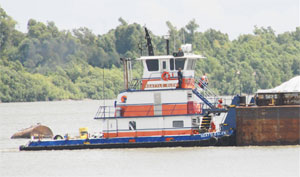The captain of a Mississippi River fleet boat is missing and presumed dead after the vessel capsized and sank near the Myrtle Grove fleeting area in Louisiana.
Three mariners were aboard the 1,200-hp Seattle Slew when it rolled over and rapidly sank at about 2000 on March 18 near mile marker 57. The sinking occurred outside the channel north of Pointe a la Hache, La.
“Although I do not have the specifics of what occurred, I can confirm that Seattle Slew was in the process of moving two barges at the time of the incident,” said Plaquemines Parish Sheriff’s Office Lt. Chaun Domingue.
Two other crewmembers escaped from the towboat before it went down. They were rescued by another towboat operating nearby, according to Turn Services of New Orleans, which operated Seattle Slew and the good Samaritan vessel. Both survivors wore life jackets.
The sheriff’s office identified the missing captain as David Mills of Marrero, La. His remains had not been recovered at press time.
The Coast Guard is investigating but has not yet determined the cause of the sinking. It did not provide additional details about the incident or confirm the description provided by the sheriff’s office.
The service issued two safety notices after the incident suggesting that it mirrored two other casualties that occurred during high, fast water on the Lower Mississippi.
“These cases are all under investigation by the Coast Guard, but the preliminary fact-finding indicates there are some similarities between the three incidents,” the Coast Guard said in a safety alert issued March 27. “In all three cases, towing vessels became pinned against another object in an aspect that exposed the vessel broadside to very strong currents. Once in that position, the vessels could not recover and sank.”
The alert recommended that operators “minimize the number of operations which require the vessel to be positioned beam-to the river current.”
River conditions at Pointe a la Hache at the time of the incident were not available. However, the Carrollton Gauge in New Orleans, roughly 55 miles upriver, recorded 16.8 feet at the time of the incident with a 6.5-knot current. Flood stage at Carrollton is 17 feet.
The safety alert noted that fast current can significantly reduce response time. Current running at about 6 knots, for instance, would cover the length of a football field in just 30 seconds.
The other notice, issued by K.M. Luttrell, Coast Guard captain of the port in New Orleans, established safety rules for when water rises above 16 feet on the Carrollton Gauge. Luttrell prohibited transits between anchored ships and required at least one foot of freeboard for towboats shorter than 79 feet. The notice also required at least 320 horsepower for each barge in the tow.
The Coast Guard joined state and local authorities in a search for Seattle Slew’s captain that lasted nearly 18 hours and covered 158 square miles. The service called off its effort on March 19, but the Plaquemines Parish Sheriff’s Office has continued to search for Mills daily by boat and weekly by helicopter.
“We will continue to search for Mr. Mills until he is recovered,” Domingue said in an email in early April.
The Coast Guard closed the Lower Mississippi River between mile markers 55 and 58 at 2330 on March 18 and reopened it at 1316 the next day after the sunken towboat was found. Turn Services ultimately located the vessel at mile marker 57, the Coast Guard said in a prepared statement. Crews were delaying the salvage until the water level dropped.
In a statement issued shortly after the incident, Turn Services thanked everyone who responded to the incident.
“At this moment our entire focus and attention is geared toward the search for our missing teammate,” the company said. “We extend our sincere thoughts and prayers to all the crewmembers involved, their families and to the rest of our Turn Services team.”
The company did not respond to a request for additional comment on the incident.

